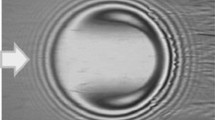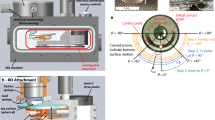Abstract
Numerical results were calculated for the dynamic behavior of an ultrathin liquid (lubricant) surface resulting from repetitively applied pressure and shear stress using the frequency domain equation and compared with those obtained using the time domain equation. Frequency domain analyses of the dynamic behavior of the ultrathin liquid (lubricant) surface produced by sinusoidally applied pressure and shear stress clarified the dependence of the liquid surface deformation on the frequency of the stresses and the disk speed. The dynamic behavior resulting from sinusoidally applied pressure and shear stress calculated using the time domain equation were found to gradually coincide with those obtained using the frequency domain equation.














Similar content being viewed by others
References
Dai Q, Hendriks F, Marchon B (2004) Modeling the washboard effect at the head/disk interface. J Appl Phys 96:696–703
Fukui S, Kaneko R (1988) Analysis of ultra-thin gas film lubrication based on the linearized Boltzmann equation: first report-derivation of a generalized lubrication equation including thermal creep flow. Trans ASME J Tribol 110:253–262
Fukui S, Kaneko R (1990) A database for interpolation of Poiseuille flow rates for high Knudsen number lubrication problems. Trans ASME J Tribol 112:78–83
Fukui S, Shimizu S, Yamane K, Matsuoka H (2007) Linearized analysis of the deformation of ultra-thin lubricant films under gas pressures by the long wave equation. Microsyst Technol 13:1339–1345. doi:10.1007/s00542-006-0359-9
Fukui S, Hitomi K, Shimizu S, Saeki F, Matsuoka H (2010a) Three-dimensional analyses of the ultra-thin liquid film surface (linearized analyses for the steady state). Microsyst Technol 16:85–92. Online First: doi:10.1007/s00542-008-0764-3
Fukui S, Hozumi K, Ishibashi H, Matsuoka H (2010b) Dynamic behavior of a thin liquid surface by repetitively applied stress (Numerical analyses by the long wave equation). JAMDSM 4:61–69
Israelachvili JN (1992) Intermolecular and surface forces, 2nd edn. Academic Press, London
Kubotera H, Bogy DB (2007) Numerical simulation of molecularly thin lubricant film flow due to the air bearing slider in hard disk drives. Microsyst Technol 13:859–865. doi:10.1007/s00542-006-0275-z
Matsuoka H, Yamashita Y, Ishibashi H, Saeki F, Fukui S (2010) Deformation characteristics of ultra-thin liquid film considering temperature and film thickness dependence of surface tension (Numerical analyses by the long wave equation). JAMDSM 4:391–396
Oron A, Davis SH, Banhoff SG (1997) Long-scale evolution of thin liquid films. Rev Mod Phys 69:931–980
Pit R, Marchon B, Meeks S, Velidandla V (2001) Formation of lubricant “moguls” at the head/disk interface. Tribol Lett 10:133–142
Saeki F, Fukui S, Matsuoka H (2009) Analyses of lubricant deformation caused by has stress and surface tension. IEEE Trans Magn 45:5061–5064
Wu L (2006) Lubricant dynamics under sliding condition in disk drives. J Appl Phys 100:024505
Yorino K, Konishi N, Yamane K, Matsuoka H, Fukui S (2004) Lubricant deformation using long wave equation. Proc ASME Mechanical Engineering Congress V: 371–372 (in Japanese)
Author information
Authors and Affiliations
Corresponding author
Appendix: Long wave equation for a liquid thin film
Appendix: Long wave equation for a liquid thin film
The equation for liquid film deformation used for the frequency domain analyses is the long wave equation (Oron et al. 1997), which is derived from the Navier–Stokes equation by application of the lubrication theory and consideration of the force balance at the liquid–gas interface:
where the x-coordinate is fixed in space, and the surface tension γ GL at the gas–liquid interface and the viscosity of the liquid μ L are both assumed to be constant. The quantities p G and τ Gx are the external gas pressure and the shear stress acting at the gas–liquid interface, respectively, and u D is the disk velocity.
The quantity p dis is the disjoining pressure and is obtained as follows:
where A 123 is the Hamaker constant (Israelachvili 1992).
Deviations of liquid film thickness, external gas pressure, and external gas shear stress are assumed to be small compared to the characteristic values. Thus, liquid deformation can be expressed as the sum of the static deformation produced by the static stress and the dynamic deformation produced by dynamic or repetitive stresses. Therefore, the liquid film deformation h L, gas pressure p G, and gas shear stress τ GX, are respectively obtained as follows:
where h L00 is the average film thickness and p a is the atmospheric pressure. The quantities H L0, P G0, and T GX0 are the static components, and η, ψ, and δ are the dynamic components. Nondimensional variables X and T are the coordinate X = x/l and time T = ω 0 t, respectively.
Substituting Eq. A3 into Eq. A1 and neglecting terms with orders higher than the second order for H L0, P G0, T GX0, η, ψ, and δ, nondimensional H L0 and η are given by Eqs. A4 and A5, respectively.
Equation to evaluate static liquid deformation H L0
Equation to evaluate dynamic liquid deformation η
where ΛL, σ L, and ΓGL are the bearing number, squeeze number, and the nondimensional surface tension at the liquid surface, respectively. Parameters ε L and \( \tilde{A} \) are given as ε L = h L00/l and \( \tilde{A} = A_{123} /\pi p_{a} h_{L00}^{3} \).
These equations are nondimensional forms of the static and dynamic components of the linearized equation. In Eq. A5, the first term is the time term, the second term is the gas pressure term, the third term is the surface tension term, the fourth term is the disjoining pressure term, the fifth term is the shear stress term, and the sixth term is the velocity term. On the other hand, Eq. A4 for static deformation H L0 is calculated for a given static pressure distribution P G0, and static shear stress distribution T GX0. The actual liquid film deformation is the superposition of H L0 and η obtained from Eqs. A4 and A5, respectively.
Rights and permissions
About this article
Cite this article
Fukui, S., Hozumi, K. & Matsuoka, H. Frequency domain analyses of a thin liquid film surface by repetitively applied stress (dynamic response analyses by the long wave equation). Microsyst Technol 17, 1099–1107 (2011). https://doi.org/10.1007/s00542-010-1214-6
Received:
Accepted:
Published:
Issue Date:
DOI: https://doi.org/10.1007/s00542-010-1214-6




